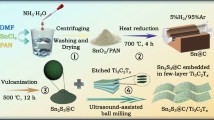Abstract
Lithium–sulfur (Li–S) batteries have attracted great interest owing to their high energy density. However, shuttling of polysulfides deteriorates the electrochemical performance of Li–S batteries and prevents their practical applications. Placing a conductive and porous interlayer structure between the cathode and the separator limits the shuttling effect and improves the cycling performance. Here, porous carbon microfibers are fabricated via a fast, safe and cost-effective centrifugal spinning approach and the resultant centrifugally spun porous carbon microfibers (CS-PCMFs) are evaluated for use as an interlayer in Li–S batteries. The highly porous fibrous structure is observed from SEM and TEM images, and a high initial discharge capacity of 1485 mAh g−1 is achieved. A high reversible capacity of 615 mAh g−1 is reached after 200 cycles at 0.2 C. In addition, the cell with CS-PCMF interlayer has low cell resistance of 25 O, whereas that of Li–S cell without interlayer is 55 O. Owing to the low cell resistance, the cell with CS-PCMF interlayer delivers the reversible capacity of around 600 mAh g−1 at 1 C, while the cell without interlayer exhibits a lower capacity of 250 mAh g−1. Therefore, this work provides a new approach for designing highly porous carbon microfiber interlayer for Li–S batteries with exceptional electrochemical performance.








Similar content being viewed by others
References
Zhu J et al (2016) Hierarchical multi-component nanofiber separators for lithium polysulfide capture in lithium–sulfur batteries: an experimental and molecular modeling study. J Mater Chem A 4(35):13572–13581
Zhu J et al (2016) Understanding glass fiber membrane used as a novel separator for lithium–sulfur batteries. J Membr Sci 504:89–96
Singhal R et al (2015) A free-standing carbon nanofiber interlayer for high-performance lithium–sulfur batteries. J Mater Chem A 3(8):4530–4538
Zu C et al (2013) Improved lithium–sulfur cells with a treated carbon paper interlayer. Phys Chem Chem Phys 15(7):2291–2297
Huang J-Q et al (2016) Porous graphene oxide/carbon nanotube hybrid films as interlayer for lithium-sulfur batteries. Carbon 99:624–632
Li Y et al (2018) Glass fiber separator coated by porous carbon nanofiber derived from immiscible PAN/PMMA for high-performance lithium-sulfur batteries. J Membr Sci 552:31–42
Selvan RK et al (2018) Biomass-derived porous carbon modified glass fiber separator as polysulfide reservoir for Li-S batteries. J Colloid Interface Sci 513:231–239
Tan L et al (2018) Lightweight reduced graphene oxide@ MoS2 interlayer as polysulfide barrier for high-performance lithium–sulfur batteries. ACS Appl Mater Interfaces 10(4):3707–3713
Ma G et al (2014) Enhanced cycle performance of Li–S battery with a polypyrrole functional interlayer. J Power Sources 267:542–546
**ng L-B et al (2016) Nitrogen, sulfur-codoped graphene sponge as electroactive carbon interlayer for high-energy and-power lithium–sulfur batteries. J Power Sources 303:22–28
Huang Y et al (2015) Flexible cathodes and multifunctional interlayers based on carbonized bacterial cellulose for high-performance lithium–sulfur batteries. J Mater Chem A 3(20):10910–10918
Yang J et al (2016) A free-standing sulfur-doped microporous carbon interlayer derived from luffa sponge for high performance lithium–sulfur batteries. J Mater Chem A 4(37):14324–14333
Su Y-S, Manthiram A (2012) Lithium–sulphur batteries with a microporous carbon paper as a bifunctional interlayer. Nat Commun 3:1166
An D et al (2019) An ultrathin and continuous Li4Ti5O12 coated carbon nanofiber interlayer for high rate lithium sulfur battery. J Energy Chem 31:19–26
Zhu J et al (2019) A polysulfide-trap** interlayer constructed by boron and nitrogen co-doped carbon nanofibers for long-life lithium sulfur batteries. J Electroanal Chem 833:151–159
Zhang K et al (2014) From filter paper to carbon paper and toward Li–S battery interlayer. Mater Lett 121:198–201
Chai L et al (2015) Porous carbonized graphene-embedded fungus film as an interlayer for superior Li–S batteries. Nano Energy 17:224–232
Park J et al (2017) Tungsten disulfide catalysts supported on a carbon cloth interlayer for high performance Li–S battery. Adv Energy Mater 7(11):1602567
Ma Z et al (2016) The enhancement of polysulfide absorbsion in LiS batteries by hierarchically porous CoS2/carbon paper interlayer. J Power Sources 325:71–78
Chung S-H, Manthiram A (2014) A hierarchical carbonized paper with controllable thickness as a modulable interlayer system for high performance Li–S batteries. Chem Commun 50(32):4184–4187
Li S et al (2017) Carbonized cellulose paper as an effective interlayer in lithium-sulfur batteries. Appl Surf Sci 396:637–643
Kong L-L et al (2016) Porous carbon paper as interlayer to stabilize the lithium anode for lithium–sulfur battery. ACS Appl Mater Interfaces 8(46):31684–31694
Wang J, Yang Y, Kang F (2015) Porous carbon nanofiber paper as an effective interlayer for high-performance lithium-sulfur batteries. Electrochim Acta 168:271–276
Yanilmaz M et al (2015) SiO2/polyacrylonitrile membranes via centrifugal spinning as a separator for Li-ion batteries. J Power Sources 273:1114–1119
Dirican M et al (2015) Flexible binder-free silicon/silica/carbon nanofiber composites as anode for lithium–ion batteries. Electrochim Acta 169:52–60
Su Y-S, Manthiram A (2012) A new approach to improve cycle performance of rechargeable lithium–sulfur batteries by inserting a free-standing MWCNT interlayer. Chem Commun 48(70):8817–8819
Zhu J et al (2016) Highly porous polyacrylonitrile/graphene oxide membrane separator exhibiting excellent anti-self-discharge feature for high-performance lithium–sulfur batteries. Carbon 101:272–280
Jiang H et al (2015) Centrifugally-spun tin-containing carbon nanofibers as anode material for lithium-ion batteries. J Mater Sci 50(3):1094–1102. https://doi.org/10.1007/s10853-016-0574-4
Balach J et al (2015) Mesoporous carbon interlayers with tailored pore volume as polysulfide reservoir for high-energy lithium–sulfur batteries. J Phys Chem C 119(9):4580–4587
Liu Y et al (2018) Fe3O4-Decorated Porous Graphene Interlayer for High-Performance Lithium-Sulfur Batteries. ACS Appl Mater Interfaces 10(31):26264–26273
Liang G et al (2016) Ultrafine TiO2 decorated carbon nanofibers as multifunctional interlayer for high-performance lithium–sulfur battery. ACS Appl Mater Interfaces 8(35):23105–23113
Huang J-Q et al (2015) Novel interlayer made from Fe3C/carbon nanofiber webs for high performance lithium–sulfur batteries. J Power Sources 285:43–50
Acknowledgements
This research was supported by The Scientific and Technology Research Council of Turkey (TUBITAK) under 2219 Grant program.
Author information
Authors and Affiliations
Corresponding authors
Additional information
Publisher's Note
Springer Nature remains neutral with regard to jurisdictional claims in published maps and institutional affiliations.
Rights and permissions
About this article
Cite this article
Yanilmaz, M., Asiri, A.M. & Zhang, X. Centrifugally spun porous carbon microfibers as interlayer for Li–S batteries. J Mater Sci 55, 3538–3548 (2020). https://doi.org/10.1007/s10853-019-04215-y
Received:
Accepted:
Published:
Issue Date:
DOI: https://doi.org/10.1007/s10853-019-04215-y




